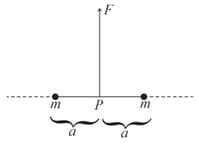If electrons move out of a body to another body every second, then the time required to get a total charge of on the other body is
Important Questions on Electrostatics
Two charges of equal magnitudes and at a distance exert a force on each other. If the charges are halved and distance between them is doubled, then the new force acting on each charge is
(Take )
Four point charges are located at the corners of a square of side The force acting on a charge of placed at centre of the square is

Two equal point charges of each are located at points and . What is the magnitude of electrostatic force between them?
As shown in the figure, two particles, each of mass tied at the ends of a light string of length are kept on a frictionless horizontal surface. When the mid point of the string is pulled vertically upwards with a small but constant force the particles move towards each other on the surface. Magnitude of acceleration of each particle, when the separation between them becomes is


